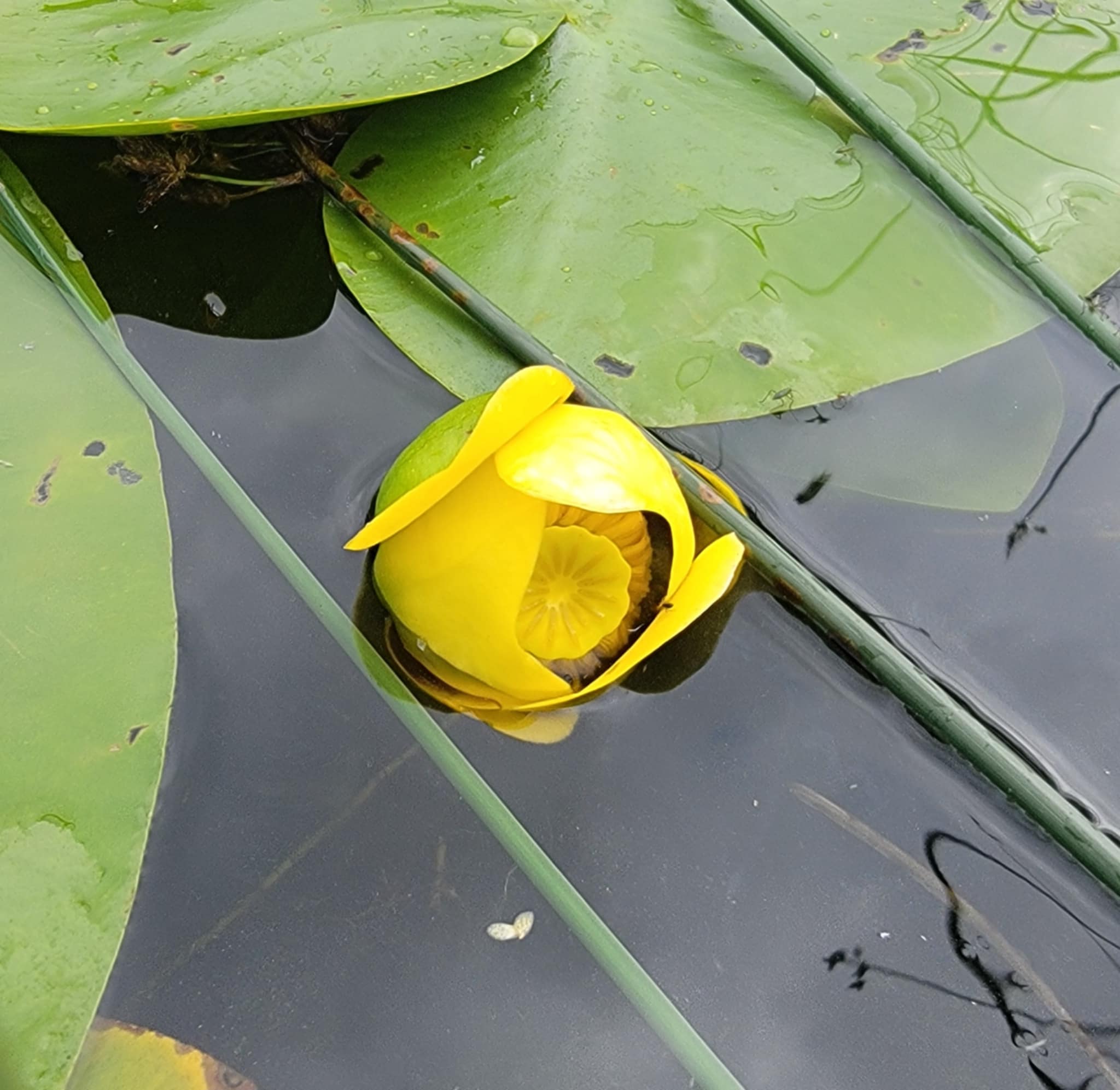Katie Byerly of Cerro Gordo County is also known as Iowa Prairie Girl on YouTube.
Occasionally when I go fishing with my husband, the desired fish will be in the “shallows” of the lake. Fishing the shallows often requires casting from the boat towards shore. For any wildflower-loving fisherperson, this opens up the opportunity to observe the aquatic plants growing around the anchored boat.
That is how I first recall noticing Spatterdock—casting for walleyes in Clear Lake.

Spatterdock (Nuphar variegata), also known as Yellow pond-lily, is native to all parts of the continental U.S. and Canada. It thrives in the mucky soils of ponds and lakes; its spongy rhizomes anchor into the muddy lake bottoms. It sends up stout stems for lily pads and one flower. The flower attempts to rise out of the water. Sometimes it just makes it to the water surface or gets caught between lily pads.

Each plant has a single golden yellow cup-like flower. Before the flower blooms, it is completely enclosed and protected by green sepals. This image shows a flower bud at the water’s surface.

This is where things get mucky for me. The single flower has six outer protective sepals, which are green on the outside. When the flower opens. . . the outside of the sepals turn yellow, keeping some green towards the base. The inside of the sepals are a bright golden yellow with a dark red base. I think I have that right.


The opened petal-like sepals create the beautiful golden globe that shields the lily’s flower. Inside we find a center disk surrounded by yellow scale-like petals. The numerous stamens and stigmas are hidden within the thick, showy sepals.

The flower will bloom for a few days, opening in the morning and closing at night. The opened flower is up to 2 inches high and 3 inches wide.
Another name for Spatterdock is bullhead lily. The best explanation I can find for this is that it reminded past Iowa fishermen of the yellow rounded head of their beloved bullheads. (I’m a walleye-eating girl myself).

In their book Wildflowers and Other Plants of Iowa Wetlands, Sylvan Runkel and Deen Roosa describe the leaves of the Spatterdock as follows:
The flat, smooth leaves are broadly oval, sometimes more than 1 foot long and 9 inches wide. Leaf margins are smooth, usually with a deep narrow notch to the petiole attachment. The leaves have more of a midrib than other waterlilies. They usually float on the water surface but may be submerged or held about the surface.
This image shows the notch and midrib as Runkel and Roosa describe.

Heart-shaped in another way to describe Spatterdock’s leaves. Some say they resemble the leaves of Common dock.

As the flower matures, the sepals and flower petals fall off, leaving a ridged, pear-shaped fruit.

Inside it contains fruit that resembles popcorn. The seed heads ripen and burst open, broadcasting or “spattering” the seeds over the water’s surface.

Spatterdock in Iowa blooms from May to October. According to Runkel and Roosa, it is found sparingly in Iowa mainly in the northern parts of the Des Moines Lobe. So if you ever find yourself in some slow-moving, shallow waters of north Iowa, be sure to look for American lotus, White water lily, and Spatterdock.



1 Comment
Thanks for the happy memories, Katie
I spent occasional time in Michigan lakes long ago, and the spatterdock was so bright and beautiful that it seemed almost magical. These wonderful photos really bring back what it was like to see spatterdock just a few feet from a canoe.
Unfortunately, there is an invasive exotic plant in Iowa that looks somewhat like spatterdock but is very bad news for bodies of water. Yellow floating heart (Nymphoides peltata) is native to Eurasia and grows in lakes and marshes like spatterdock. But the yellow flowers are smaller and have fringed petals, and the flat leaves are smaller with purple undersides.
Yellow floating heart is illegal to possess, sell, or transport in Iowa and in some other states. But as so often happens, the nursery industry had already spread it across the Midwest by the time it was officially recognized as a severe threat to aquatic ecosystems. Yellow floating heart does not belong in water gardens or anywhere else in Iowa, and sightings should be reported to the DNR.
PrairieFan Wed 1 Oct 11:42 AM